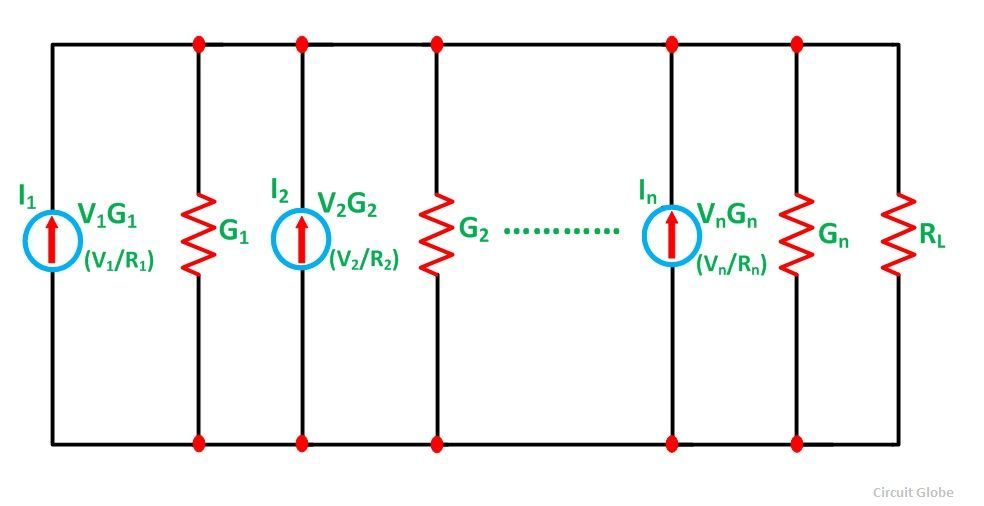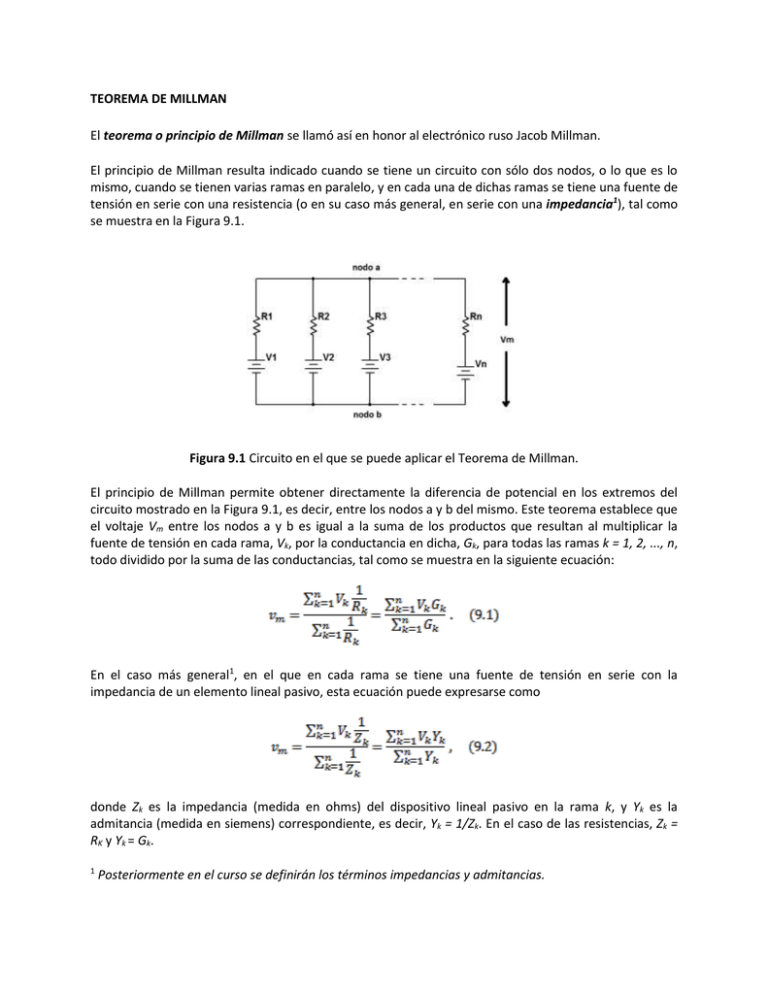
Millman Theorem Example 1 (with simulation) YouTube
10.6: Millman's Theorem. Page ID. Tony R. Kuphaldt. Schweitzer Engineering Laboratories via All About Circuits. In Millman's Theorem, the circuit is re-drawn as a parallel network of branches, each branch containing a resistor or series battery/resistor combination. Millman's Theorem is applicable only to those circuits which can be re.

Teoremas millman y potencia
Teorema di Millman Viene applicato a circuiti costituiti da n rami in parallelo. Ipotizzando che A e B siano i morsetti in comune fra gli n rami la tensione V AB risulta uguale alla corrente che si ottiene mettendo in corto circuito i morsetti A e B ; essa è data da : moltiplicata per la resistenza R AB vista fra i morsetti in questione:

Millman's Theorem YouTube
Millman circuits are formed exclusively by resistors and there is no reactance involved. The total output voltage of a circuit, as stated by Millman's theorem, can be expressed by the first Ohm's law. To find the Millman equivalent circuit, the load must be removed. To find the Millman equivalent resistance, the voltage sources is replaced with.

07 Teorema di Millman
The polarity of all voltages in Millman's Theorem are referenced to the same point. In the example circuit above, I used the bottom wire of the parallel circuit as my reference point, and so the voltages within each branch (28 for the R 1 branch, 0 for the R 2 branch, and 7 for the R 3 branch) were inserted into the equation as positive numbers. Likewise, when the answer came out to 8 volts.

Teorema de Millman UNIGAL
How to find the equivalent Millman circuit? "RM" is obtained. RM is the value of the equivalent resistance in parallel of all the resistors that are in series with the voltage sources. 1/RM = 1/REq = 1/R 1 + 1/R 2 + + 1/R n.; VM" is obtained using the following formula:

Millman's theoremhi.wmv YouTube
In this case, the resistance total will be equal to 571.43 milliohms (571.43 mΩ). We can re-draw our equivalent circuit now as one with a single Norton current source and Norton resistance: Ohm's Law can tell us the voltage across these two components now (E=IR): E total = (14 A) (571.43 mΩ) E total = 8 V. Let's summarize what we know.

TEOREMA DI MILLMAN YouTube
The polarity of all voltages in Millman's Theorem are referenced to the same point. In the example circuit above, I used the bottom wire of the parallel circuit as my reference point, and so the voltages within each branch (28 for the R 1 branch, 0 for the R 2 branch, and 7 for the R 3 branch) were inserted into the equation as positive numbers. . Likewise, when the answer came out to 8.

TEOREMA DE MILLMAN El teorema o principio de Millman se llamó
Millman's Theorem Formula According to Ohm's law; Where I and R is the total circuit current and total circuit resistance respectively. Total circuit Current is; Total circuit resistance is; Putting the values of equations (2) & (3) in equation (1), we get The generalized form of Millman's equation for "k" parallel circuits is;

Millman Theorem Example 2 YouTube
According to Millman's theorem , in circuits with voltage sources: The total voltage or potential difference between any two terminals in a circuit is equal to: Where, i = the current flowing through each branch. G = = Admittance of each parallel branch or current source where , R = Internal resistance of each parallel branch or current source.

Théorème de Millman YouTube
The utility of Millman's Theorem is that the number of parallel voltage sources can be reduced to one equivalent source. It is applicable only to solve the parallel branch with one resistance connected to one voltage source or current source. It is also used in solving network having an unbalanced bridge circuit. As per Millman's Theorem.

Théorème de Millman démonstration + exercices corrigés
Here, the example circuit of Millman's theorem is shown below. Millman's Theorem Circuit. To apply Millman's Theorem, again this circuit can be redrawn like the following. When both the voltage supply and resistance are considered in every branch, then this theorem notifies the voltage across all branches In the above circuit, the voltage.

Ep 24 circuit théorème de millman darija YouTube
What is meant by Thevenin's theorem? Click Here! Theory of Millman's Theorem Millman's Theorem: It states that if multiple voltage sources (having internal resistances) are connected in parallel, this specific circuit can be replaced by a simpler circuit of a single voltage source and a resistance in series.

Teorema de Millman Resolvendo questões YouTube
In electrical engineering, Millman's theorem [1] (or the parallel generator theorem) is a method to simplify the solution of a circuit. Specifically, Millman's theorem is used to compute the voltage at the ends of a circuit made up of only branches in parallel . It is named after Jacob Millman, who proved the theorem. Explanation

Le Théorème de Millman et ses applications Le Magazine Scientifique
Use Millman's theorem to calculate the total voltage between the two busses for the battery bank, given these specifications for the four batteries: Battery Voltage R connection+ R connection− R internal 1 11.9 1.2Ω 1.1Ω 5.5Ω 2 12.2 1.0Ω 1.3Ω 5.1Ω 3 12.0 1.4Ω 0.9Ω 4.7Ω 4 12.1 1.1Ω 1.2Ω 5.5Ω file 00474 6

Millman's Theorem
To solve for resistor voltage drops, the Millman voltage (across the parallel network) must be compared against the voltage source within each branch, using the principle of voltages adding in series to determine the magnitude and polarity of the voltage across each resistor: Solving for Branch Currents

Applicazione del teorema di Millman, esercizio guidato YouTube
Millman circuits are formed exclusively by resistors and there is no reactance involved. The total output voltage of a circuit, as stated by Millman's theorem, can be expressed by the first Ohm's law. To find the Millman equivalent circuit, the load must be removed. To find the Millman equivalent resistance, the voltage sources is replaced with.